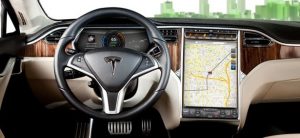Vehicle infotainment systems have been advancing at a rapid pace driven by the development of new technologies. Once composed of AM radios and cigarette lighters, infotainment systems now include voice controls, navigation, parking assistance, and much more. The infotainment technologies market is dominated by a select few auto suppliers, but Tesla is disrupting the supply chain by manufacturing much of its own technologies in house. While Tesla may have started a trend that some major manufacturers are following, this may be a non-factor for increasing vehicle sales. Studies show that many consumers pay little attention to their infotainment systems, often finding them confusing. In the age of the smart phone, most consumers prefer to use their smart phones for many of the services that in-car infotainment systems have to offer such as navigation and music.
The infotainment sector is dominated by top suppliers such as Denso, Harman, Delphi, Blaupunk GmbH, and Continental. Audio Systems manufacturers such as Bose and Kenwood have also found a foothold in the market due to in car audio being possibly the most recognizable component of the infotainment system. While these manufacturers have solidified their place in the supply chain, Tesla is disrupting the status quo. In making the model S, Tesla reportedly “spent almost as much time designing the infotainment system as they did the car itself”. Some manufacturers such as Ford are following Tesla’s lead in manufacturing infotainment systems partially in house. Other manufacturers such as Volkswagen and Audi maintain collaborative relationships with suppliers lower on the supply chain to produce their infotainment systems. While it seems that the supply chain for infotainment in vehicles is changing, this may have less of an effect on overall car sales and customer satisfaction than Tesla would hope.
A JD Power study showed that “more than 50% of car owners never used their infotainment systems after 90 days of purchase”. Consumers find these systems too technical and difficult to understand. While many cars now come with GPS navigation as a part of the infotainment system, many consumers prefer to use an application such as google maps on their smartphones. This does not mean that infotainment systems are obsolete and have no impact on a consumers decision to purchase a vehicle. Consumers are more satisfied with collision prevention systems such as rear view backup cameras and lane assistance. Manufacturers may want to focus more on collision prevention technologies than fancy dashboard entertainment systems.
http://www.ebnonline.com/author.asp?section_id=1162&doc_id=277232
https://www.technavio.com/blog/top-12-automotive-infotainment-companies
http://www.businessinsider.com/people-opt-to-use-cell-phones-over-infotainment-consoles-in-cars-2017-4
What portion of the infotainment system is Tesla doing? Surely not their own speakers and amp/tuner and all that. For the software end, many firms are using ApplePlay and a comparable systems (something from Google for Android phones) that integrate phones. Yes, the OEMs have to integrate the control of vehicle functions and may add links to a built-in GPS system (if only to benefit from a roof-mounted antenna). And these systems are often clunky. What of Tesla’s? What do reviews say?
However, Tesla’s success (such as it is) relies upon suppliers. Because they can use the engineering of suppliers for everything from suspension and power transmission components to air conditioning and interiors they didn’t have to do as much engineering themselves. From a technical standpoint it’s easier to enter the industry in 2017 than in 1987 because firms can buy outside expertise bundled with actual components. In econ lingo, the fixed costs (and hence economies of scale) in vehicle engineering are lower. OEMs do less, not more.
I’ve visited multiple suppliers of Tesla components, and understand from them that their role was great. One advantage: with a clean sheet of paper approach and Tesla engineers having little in the way of company design tradition, suppliers are freer to “do things right.” That is, they’re not constrained by history. Of course Tesla’s strategy is not informed by history, and they have less experience at integrating components and at controlling engineering choices for their current manufacturing capabilities. So the sum of the parts isn’t necessarily better at Tesla.
Do you think Tesla is going to continue pushing these kinds of systems into their low end cars as well? It will be good to see how the company adapts many of its features towards a market that will not want many top features as before. Also, this likely will provide a whole new wealth of issues as Tesla adapts a new dashboard vs the one it knows.
With consumers having such little focus on infotainment systems it really makes me wonder why Tesla is so focused on putting more R&D and investment into improving them and becoming a force in that specific sector? In my opinion most consumers seem to want to have products that are extremely simple to use (like an app for directions on their phone) rather than the extremely tech savy infotainment systems that are currently being cranked out. But it will be interesting to see if Tesla innovates in this area by the time their model 3 comes out.
This seems like a positive move for Tesla because they understand their market. Many of their buyers are wealthy Californians that are interested in the latest technology, but I also think those purchasing the Model 3 will want this as well. People forget, but many of the pre-orders for the Model 3 come from the same market as their other cars.